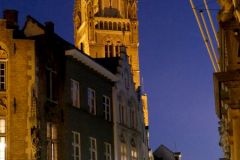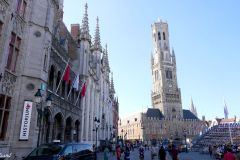This serial heritage site, Belfries of Belgium and France, consists of 33 belfries scattered across both regions of Belgium and 23 in Northern France. Once you are in the right town finding the belfry is piece of cake really. Just look for the tallest old structure.
The UNESCO World Heritage List includes more than a thousand properties with outstanding universal value. They are all part of the world’s cultural and natural heritage.
Official facts
- Country: Belgium
- Date of Inscription: 1999
- Category: Cultural site
UNESCO’s World Heritage Centre’s short description of site no. 943:
Twenty-three belfries in the north of France and the belfry of Gembloux in Belgium were inscribed as a group, an extension to the 32 Belgian belfries inscribed in 1999 as Belfries of Flanders and Wallonia. Built between the 11th and 17th centuries, they showcase the Roman, Gothic, Renaissance and Baroque styles of architecture. They are highly significant tokens of the winning of civil liberties. While Italian, German and English towns mainly opted to build town halls, in part of north-western Europe, greater emphasis was placed on building belfries. Compared with the keep (symbol of the seigneurs) and the bell-tower (symbol of the Church), the belfry, the third tower in the urban landscape, symbolizes the power of the aldermen. Over the centuries, they came to represent the influence and wealth of the towns.
More about the heritage site
The belfry in Brussels would have been included but was already a central part of another heritage site in Belgium, the Grand-Place. The belfries where built from the 11th century and onward. Wars and fires have tormented the buildings time and again, but they were rebuilt and even expanded every so often.
The belfries are bell-towers but in essence not part of churches, although some actually are. The belfry symbolises the growth of urban communities, trade, commerce and the development of a bourgeoisie. The religious world had their churches and spires, the nobility lived in medieval fortresses with a stronghold inside called the keep. As the centuries went by, the belfries changed their appearance from having defensive capabilities to becoming narrower and more elegant. In recent centuries they came to symbolise even more values like independence and prosperity of the town and its inhabitants.
My visit
In 2017 I visited the belfry in Bruges, easily seen from all across the inner city (which is also a world heritage site). A dominating feature on the medieval town square, the Markt, the belfry towers 83 metres into the air from its base in the old warehouse and market halls. One may want to climb it, by way of 366 steep steps, for a panoramic view of Bruges. Inside there is a museum and also a large bell called the Triumphant Bell. A carillon instrument is also located here, with which the player creates melodies out of 47 bells by hitting sticks on a keyboard.
The belfry of Bruges dates back to 1240, however it was destroyed and rebuilt several times. The American poet Henry Wadsworth Longfellow wrote this some time in the 19th century:
In the market-place of Bruges stands the belfry old and brown; Thrice consumed and thrice rebuilded, still it watches o’er the town.
The story from my visit is yet to be written.
Browse to the PREVIOUS or NEXT post in this series.








